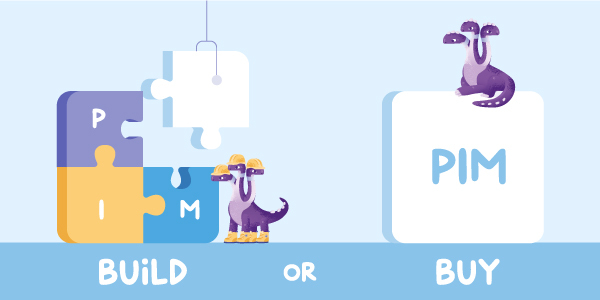So, you’ve decided it’s time for your organization to adopt a product information management (PIM) platform.
Now, it’s time to make another, perhaps even more important decision — to build or buy. Will you call on your team of developers to build your own PIM, or will you buy a subscription to a PIM platform from one of the many solution providers on the market?
While both building and buying a PIM have pros and cons, we believe that for most organizations, there is a definitive answer to this question — namely, buying a purpose-built PIM solution from a software vendor. Why are we so confident in that? Allow us to explain!
Cost
Let’s start with the most obvious perceived advantage that home-grown systems have over their licensed counterparts — the initial cost. If your company already employs software developers or designers, you may be thinking, why not use those resources to create a PIM rather than pay a large upfront cost or an ongoing licensing fee? You may avoid the upfront operational expense of a packaged PIM subscription when you develop your own solution, but you won’t avoid the ongoing maintenance and upkeep that your custom application will require.
When running as an on-premises application, you’ll need to factor in the capital cost of hardware acquisition and upkeep, as well as integration, connectivity, and remote access, especially now. With a purchased, cloud-based PIM, however, the software provider deals with all of the costs associated with maintaining the solution, including, but not limited to enhancements, fixes, upgrades, and more, allowing you to avoid spending money on depreciating assets like hardware, and the expense to support a technology that is on the critical path to getting your products ready for sale.
Resources
Hardware and software costs are not the only resources you need to consider. To build your own PIM will require significant resources. Consider what a software vendor requires to develop a solution: dozens of dedicated software engineers, product and project managers, and technical support resources who work 100% on PIM, and nothing else. These dedicated individuals spend thousands of person-hours and hundreds of thousands of lines of code, or more, to make a PIM solution that can support all your channels, products, and markets.
In order for your organization to even begin to realize the benefit from a PIM solution, you’ll have to make a major investment, not just with your money, but with your people, your processes, and your priorities. Or, if you want to run your business in the most efficient manner possible, you could work with a PIM vendor that has already invested all of this, and more, into their solution.
Control
When it comes to building your own solution, one of the biggest benefits is control. When you’re the owner, creator, and manager of a PIM platform, you have complete control over how the software works. You and your team get to decide what features are the most important to include, what UI is best for your team, and how to prioritize updates, fixes, and other decisions that need to be made. But with great power comes great responsibility.
Building your own PIM system means that you are responsible for updating that solution, which in turn means making all of the decisions when it comes to adding new features or making changes to the solution. But when you buy, your software vendor will constantly be updating the SaaS PIM solution with an ongoing stream of upgrades and enhancements, doing so at a rate that your IT team simply won’t be able to keep up with. By working with a solution provider, you don’t have to worry about enhancing or maintaining your solution, and instead be able to focus more on using that solution to provide the best product experiences possible.
Features
Most likely, if you’re reading this blog, you’re not a software developer yourself. You’re an artisan working to design beautiful and comfortable furniture, a manufacturer shipping products to retailers around the world, a retailer yourself, or a distributor. If you want your PIM solution to have the latest and greatest capabilities, including tools like embedded workflows, user management features, support for product variants, an integrated way to manage digital assets, data quality insights, and more, you shouldn’t be opting for a homegrown solution.
Buying a PIM is the fastest and easiest way to keep pace with advances in the solution needed to keep your business growing. That way, you can focus on selling your products and not worrying about maintaining the tools you use to get them ready to sell. So, rather than spending valuable resources outside of your core competency, leave designing a PIM solution to the experts who concentrate on doing this on a daily basis. That way, you can focus on running your business while your solution provider takes care of running your PIM instance smoothly and securely on a cloud infrastructure.
Speed
We’ll wrap up with one of the biggest benefits of any PIM, bought, built, or otherwise, is the enhanced product creation and enrichment speeds, leading to accelerated time-to-market. This gives your team more selling days while reducing enrichment costs, helping drive revenue skyward.
But developing, designing, and perfecting a PIM is a complex, time-consuming endeavor. If you’re wasting time building your own home-brewed solution, your team may never realize these benefits! Buying a packaged solution allows you to get your new PIM up and running almost instantly, allowing you to start experiencing the benefits and tracking the ROI of your investment in PIM.
Build or Buy — what’s right for you?
When you consider all of the factors that go into making the decision to build or buy software — from the time and cost of implementing a new solution to the speed you can implement it in and even the features it offers — it’s clear that buying a PIM system is the right answer for most organizations. Buying a PIM system allows you to focus on creating great experiences for your customers and growing your business without wasting time, money, effort, or any other resources outside of your core competency.
But which solution on the market is right for you and your team? If you need help answering that question, check out our guide to the
issues to consider when (s)electing a PIM candidate!


